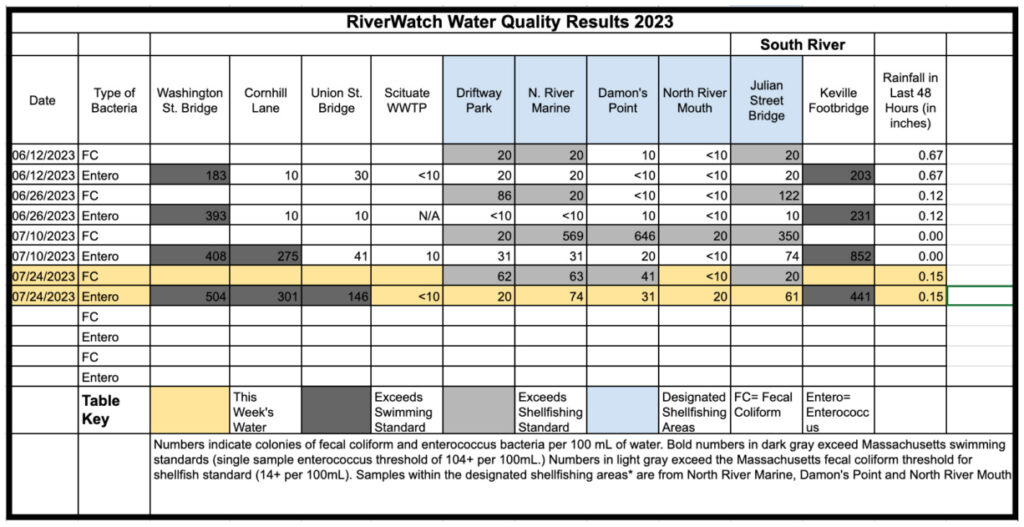The RiverWatch Water Quality surveys determine whether or not sites along the North and South Rivers have exceeded colony concentration numbers per Massachusetts’ swimming and shellfishing standards. Enterococcus colonies were collected at all ten sites along the North and South Rivers, while fecal coliform samples were collected in shellfish growing areas (none of which are open at the moment for harvest). According to Massachusetts’ swimming standards, enterococcus levels may not exceed 104 cfu per 100mL of water sampled. The Mass. Division of Marine Fisheries shellfishing standard is 14 cfu per 100mL of fecal coliform.
For the week of July 24th, water at Washington St. Bridge, Cornhill Lane, Union St. Bridge, and Keville Footbridge exceeded the Massachusetts’ swimming standard for enterococcus. Water at Washington St. Bridge and Keville Footbridge has had a consistently high concentration of enterococcus in the past three rounds of sampling, but Cornhill Lane has increased from 275 cfu per 100mL to 301 cfu, still exceeding the standard. The cfu values of Washington St. Bridge, Cornhill Lane, and Union St. Bridge sites have continually increased over the past 4 rounds of sampling, while a decrease has occurred at Keville Footbridge.
Shellfish beds are closed from May 31 until November 1, so the information presented in this section is purely for informational purposes. Concentrations of fecal coliform exceeded the shellfish standard at Driftway Park, North River Marine, Damon’s Point, and Julian Street Bridge. These levels are in fact lower than the past 2 years, meaning that improvements to the area have been beneficial. However, some caution must still be taken as now all designated shellfish areas still exceed the standard for consumption per Massachusetts regulation.
In this round of sampling both enterococcus and fecal coliform concentrations were consistently high at the same sites, some new sites, and certain sites have increased compared to the last round. While there hasn’t been large consistent amounts of rainfall like in the last round of sampling, more recent rainfall in the area may be a cause for higher concentrations at some sites as well as continually increasing temperatures. Based on data from the past 5 years, when we have between 0.1 and 0.25 inches of rain (like this last week’s sampling) Washington Street Bridge exceeds swimming standards 71% of the time and Keville Footbridge exceeds swimming standards 86% of the time. We are working to find the source(s) for bacteria at Washington Street Bridge through our Headwaters Project in partnership with the Town of Hanover. We have made similar efforts for the Keville Footbridge area of the South River in the past with no clear answer. If we continue to have a rainy summer, we may be able to make stronger statements about stormwater impacts to other parts of the river as well.


